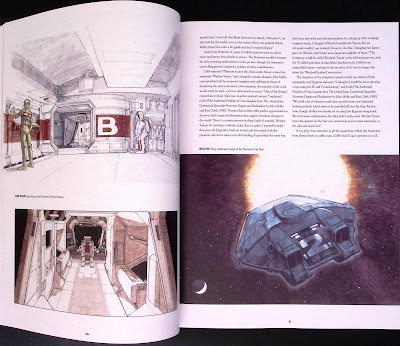In the 1930s the American author John Dos Passos (1896 – 1970) wrote three novels, referred to as the ‘U.S.A. Trilogy’, which relied on an experimental prose style. With these novels, Dos Passos adorned the traditional, main narrative with insertions of vignettes: a ‘Newsreel’ consisting of headlines and excerpts from newspapers; stream-of-consciousness musings, labeled as ‘Camera Eye’; and song lyrics. Dos Passos intended these ancillary materials to give a more expansive quality to the narrative, placing the adventures of his characters within the larger context of the world around them, including events such as World War One, labor unrest, and the Roaring Twenties (Dos Passos, an ardent Communist, intended the trilogy to be an indictment of Capitalism).
During the 1950s and early 1960s, the U.K. writer John Brunner had made a career out of writing a large portfolio of conventional science fiction short stories and novels, but with the advent of the New Wave movement, he eagerly embraced constructing new science fiction novels on the template of Dos Passos.
Beginning with ‘Stand on Zanzibar’ in 1968, followed by ‘The Sheep Look Up’ (1972) and ‘The Shockwave Rider’ (1975), Brunner received considerable critical praise for his presentations. However, the reading public was less enthused, and by the early 1980s, Brunner had reverted to more traditional narratives.
Having read ‘Stand on Zanzibar’ in the early 80s, and finding it a bore, I was not expecting much from the March, 1976 mass-market paperback version of ‘The Shockwave Rider’ (Ballantine Books, 280 pp., cover art by Murray Tinkelman).
In his Acknowledgement, Brunner states that Alvin Toffler’s 1970 book ‘Future Shock’ was the inspiration for ‘Shockwave’, and indeed, at one point in the novel a character references ‘Toffler’s Law’, namely, “the future arrives too soon and in the wrong order.”
Brunner’s novel explores prominent Future Shock tropes, such as the universal identification card; the replacement of traditional long-term employment, and living in one locale for lengthy periods of time, by a nomadic lifestyle; and the risk of experiencing abrupt, intense nervous breakdowns (‘overload’) due to a surfeit of information.
The protagonist of ‘Shockwave’ is a man named Nickie Haflinger. Abandoned at a young age by his parents, Haflinger’s innate genius is recognized by a secretive government think tank called the Tarnover Institute. Tarnover’s purpose is to raise savants who can guide society through the era of Future Shock. Repulsed by the amorality of the Tarnover system, Haflinger escapes the institute and, a man on the run, slips from one identity to another as he negotiates an early 21st century America (as envisioned by Toffler).
‘Shockwave’ is a dull and plodding book. The narrative is divided into two storylines. One, set in the present, deals with the efforts of Tarnover personnel to subject Haflinger to a 'humane' interrogation, in the hopes of persuading him to disclose the particulars of a computer virus, or 'worm', he has uploaded to the Net.
The other storyline, interwoven with the first, is a flashback, dealing with Haflinger’s adventures following his escape from Tarnover. There are protracted discourses that present the near-future USA of Future Shock to the reader, and introduce a love interest named Kate Grierson.
Much of the book is constructed around lengthy dialogue passages in which Brunner, using his characters as mouthpieces, expounds on sociological and psychological topics. These dialogue passages have a pedantic quality that quickly becomes numbing.
With the third Book, titled ‘Splicing the Brain Race’, Brunner has an opportunity to inject some excitement into the narrative, as Haflinger and his allies prepare to bring down the government via his ‘worm’. But alas, this section also is afflicted by overwriting and wooden dialogue:
“Our society is hurtling in free fall towards heaven knows where, and as a result we’ve developed collective osteochalcolysis of the personality.”
What few moments of excitement arise in ‘The Shockwave Rider’ are scant, and limited to the later chapters, when rival biker groups decide to attack the Ecotopia where Haflinger is residing. And, when a covert, federal operative sets out to nuke the 'resistance'. Combined, these segments take up less than three pages and have a perfunctory quality.
The ‘mixed-media’ insertions into the novel – which range from a few sentences to several pages – are more like distractions, than enhancements, to ‘Shockwave’.
The verdict ? ‘The Shockwave Rider’ is yet another New Wave Era dud. While it may be said to prefigure some of the themes of cyberpunk, beyond that, it has little to recommend it.






























































.jpg)























